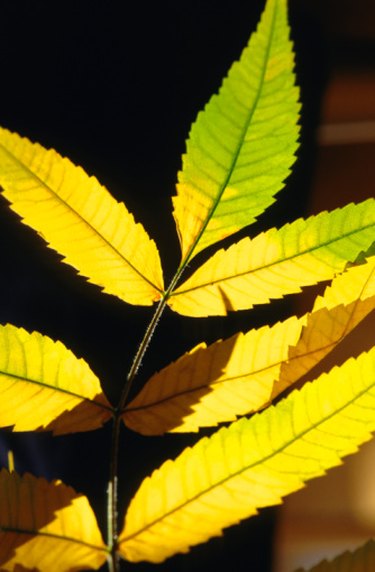
Wisteria vines, once established, are generally free of major insect and disease problems. Should the leaves start to turn brown or discolored, there are a few possible causes. If your wisteria was recently transplanted, it may be going through transplant shock as it adjusts to its new environment. Prune it back and give it some fertilizer to help it along. If it is a more mature vine, the problems are likely water, canker, nutrient or maintenance-related.
Water Issues
Video of the Day

Wisteria can tolerate a range of soils, but in all cases need they need to drain well. For new plantings, select a site where water does not puddle after heavy rains. For established wisteria that are are evincing symptoms of yellow or brown leaves, soil structure may have changed over time and they are now suffering as a result. Check for blocked downspouts or broken waterlines nearby. If they are in an area that is near salt spray used for melting snow, the sodium chloride negatively affects the soil's ability to drain. Consider using other snow and ice melters such as a calcium chloride.
Video of the Day
Canker Diseases

Canker diseases are one of the few but more common diseases that can infect wisteria and cause leaves to turn brown. Cankers are masses of dead tissue on the stems or trunks and appear as discolored sunken areas. Nutrient and water are unable to be transported to leaves and branches beyond the affected area and they begin to die. In all cases, prune out infected branches with sterile cutting tools. For wisteria that have cankers at the base of the vine, they should be cut down to the ground and may or may not regrow, but will die for sure if untreated.
Nutrient Excess/Deficiency

When wisteria are lacking certain nutrients or are in excess of some nutrients, the symptoms present themselves in the leaves. Nitrogen and iron are the most common nutrients that may be deficient in wisteria. Leaves will first turn yellow and if untreated, may turn brown. Wisteria that have some nutrients in excess such as salts often present as brown tips on the leaves or leaf margins. The only way to be sure if this is the cause is if you send a leaf sample to a diagnostic lab.
Proper Care

Proper maintenance of wisteria can help to prevent many of the causes that can cause brown leaves. Wisteria need annual pruning to keep them healthy and thriving. Main leaders should be cut back to one-half to two-thirds of their current height in late winter. Lateral branches can be cut back to two to three inches from the main stalk. During the summer, side branches can be cut back to a point six to eight leaves form the main stem.